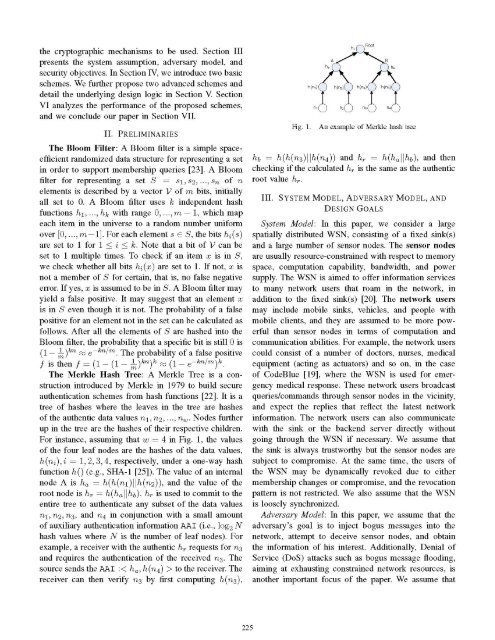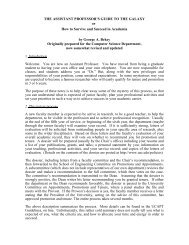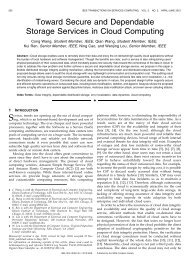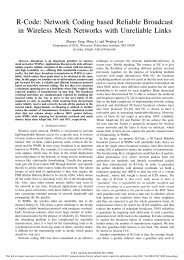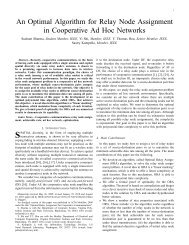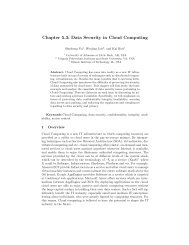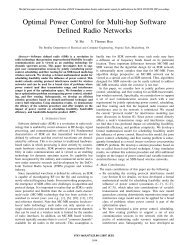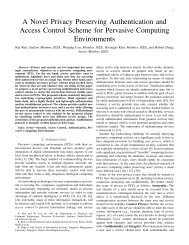all the messages received with<strong>in</strong> one time <strong>in</strong>terval, anadversary can hence flood the whole network arbitrarily.All he has to do is to claim that the flood<strong>in</strong>g messagesbelong to the current time <strong>in</strong>terval which should bebuffered for authentication until the next time <strong>in</strong>terval.S<strong>in</strong>ce wireless transmission is very expensive <strong>in</strong> WSNs,and WSNs are extremely energy constra<strong>in</strong>ed, the abilityto flood the network arbitrarily could cause devastat<strong>in</strong>gDenial of Service (DoS) attacks. Moreover, this type ofenergy-depletion DoS attacks become more devastat<strong>in</strong>g<strong>in</strong> multi<strong>user</strong> scenario as the adversary now can havemore targets and hence more chances to generate bogusmessages without be<strong>in</strong>g detected. Obviously, all theseattacks are due to delayed authentication of the broadcastmessages. In [11], TIK is proposed to achieve immediatekey disclosure and hence immediate message authenticationbased on precise time synchronization betweenthe s<strong>in</strong>k and receiv<strong>in</strong>g nodes. However, this techniqueis not applicable <strong>in</strong> WSNs as po<strong>in</strong>ted out by the authors.Therefore, multi<strong>user</strong> broadcast authentication stillrema<strong>in</strong>s a wide open problem <strong>in</strong> WSNs.When ,uTESLA was proposed, sensor nodes wereassumed to be extremely resource-constra<strong>in</strong>ed, especiallywith respect to computation capability, bandwidth availability,and energy supply [26]. Therefore, public keycryptography (PKC) was thought to be too computationallyexpensive for WSNs, though it could provide muchsimpler solutions with much stronger security resilience.At the same time, the computationally efficient onetimesignature schemes are also considered unsuitable forWSNs, as they usually <strong>in</strong>volve <strong>in</strong>tense communications[26]. However, recent studies [8], [28], [31] showedthat, contrary to widely held beliefs, PKC with evensoftware implementations only is very viable on sensornodes. For example [31], Elliptic Curve Cryptography(ECC) signature verification takes 1.61s with 160-bitkeys on ATmegal28 8MHz, a processor used <strong>in</strong> currentCrossbow motes platform [7]. Furthermore, the computationalcost is expected to fall faster than the costto transmit and receive. For example, ultra-low-powermicrocontrollers such as the 16-bit Texas InstrumentsMSP430 [30] can execute the same number of <strong>in</strong>structionsat less than half the power required by the 8-bitATmega128L. The benefits of transmitt<strong>in</strong>g shorter ECCkeys and hence shorter messages/signatures will <strong>in</strong> turnbe more significant. Moreover, next generation sensornodes are expected to comb<strong>in</strong>e ultra-low power circuitrywith so-called power scavengers such as Heliomote [15],which allow cont<strong>in</strong>uous energy supply to the nodes.At least 8- 20uW of power can be generated us<strong>in</strong>gMEMS-based power scavengers [3]. Other solar-basedsystems are even able to deliver power up to 100mW forthe MICA Motes [15], [16]. These results <strong>in</strong>dicate that,with the advance of fast grow<strong>in</strong>g technology, PKC isno longer impractical for WSNs, though still expensivefor the current generation sensor nodes, and its wideacceptance is expected <strong>in</strong> the near future [8].Hav<strong>in</strong>g this observation and know<strong>in</strong>g that symmetrickey-basedsolutions such as ,uTESLA are <strong>in</strong>sufficient forbroadcast authentication <strong>in</strong> WSNs, we resort to PKCfor more effective solutions. In this paper, we addressmulti<strong>user</strong> broadcast authentication problem <strong>in</strong> WSNs bydesign<strong>in</strong>g PKC-based solutions with m<strong>in</strong>imized computationaland communication costs.Overview of the paper: In this paper, we propose fourdifferent public-key-based approaches and provide <strong>in</strong>depthanalysis of their advantages and disadvantages.In all the four approaches, the <strong>user</strong>s are always authenticatedthrough their public keys. We first proposea straightforward certificate-based approach and po<strong>in</strong>tout its high energy <strong>in</strong>efficiency with respect to bothcommunication and computation costs. We then proposea direct storage based scheme, which has high efficiencybut suffers from the scalability problem. A Bloom filterbased scheme is further proposed to improve the memoryefficiency over the direct storage based scheme. Furthertechniques are also developed to <strong>in</strong>crease the securitystrength of the proposed scheme. Lastly, we propose ahybrid scheme to support a larger number of network<strong>user</strong>s by employ<strong>in</strong>g the Merkle hash tree technique. Wegive an <strong>in</strong>-depth quantitative analysis of the proposedschemes and demonstrate their effectiveness and efficiency<strong>in</strong> WSNs <strong>in</strong> terms of energy consumption.Contributions: This paper makes the follow<strong>in</strong>g contributions:1) We identify the problem of multi<strong>user</strong> broadcastauthentication <strong>in</strong> WSNs and po<strong>in</strong>t out a serious securityvulnerability <strong>in</strong>herent to the symmetric-key based,uTESLA-like schemes. 2) We come up with severalPKC-based schemes to address the proposed problemwith m<strong>in</strong>imized computational and communication costs.We achieve our goal by <strong>in</strong>tegrat<strong>in</strong>g several cryptographicbuild<strong>in</strong>g blocks, such as the Bloom filter, the partialmessage recovery signature scheme, and the Merklehash tree, <strong>in</strong> an <strong>in</strong>novative manner. 3) We analyze boththe performance and security resilience of the proposedschemes. A quantitative energy consumption analysis isgiven <strong>in</strong> detail and demonstrates the effectiveness andefficiency of the proposed schemes.Organization of the paper: The rema<strong>in</strong><strong>in</strong>g part ofthis paper is as follows: In Section II, we <strong>in</strong>troduce224
the cryptographic mechanisms to be used. Section IIIpresents the system assumption, adversary model, andsecurity objectives. In Section IV, we <strong>in</strong>troduce two basicschemes. We further propose two advanced schemes anddetail the underly<strong>in</strong>g design logic <strong>in</strong> Section V. SectionVI analyzes the performance of the proposed schemes,and we conclude our paper <strong>in</strong> Section VII.II. PRELIMINARIESThe Bloom Filter: A Bloom filter is a simple spaceefficientrandomized data structure for represent<strong>in</strong>g a set<strong>in</strong> order to support membership queries [23]. A Bloomfilter for represent<strong>in</strong>g a set S = sI, S2, ..., sn of nelements is described by a vector V of m bits, <strong>in</strong>itiallyall set to 0. A Bloom filter uses k <strong>in</strong>dependent hashfunctions h1, ..., hk with range 0, ..., m- 1, which mapeach item <strong>in</strong> the universe to a random number uniformover [0, ..., m- 1]. For each element s E S, the bits hi(s)are set to 1 for 1 < i < k. Note that a bit of V can beset to 1 multiple times. To check if an item x is <strong>in</strong> S,we check whether all bits hi (x) are set to 1. If not, x isnot a member of S for certa<strong>in</strong>, that is, no false negativeerror. If yes, x is assumed to be <strong>in</strong> S. A Bloom filter mayyield a false positive. It may suggest that an element xis <strong>in</strong> S even though it is not. The probability of a falsepositive for an element not <strong>in</strong> the set can be calculated asfollows. After all the elements of S are hashed <strong>in</strong>to theBloom filter, the probability that a specific bit is still 0 is(1 1)k e-k/m* The probability of a false positivef is then f = (1 -(1 - )k)k (1_ e-km)kThe Merkle Hash Tree: A Merkle Tree is a construction<strong>in</strong>troduced by Merkle <strong>in</strong> 1979 to build secureauthentication schemes from hash functions [22]. It is atree of hashes where the leaves <strong>in</strong> the tree are hashesof the authentic data values nI, n2, ..., n,. Nodes furtherup <strong>in</strong> the tree are the hashes of their respective children.For <strong>in</strong>stance, assum<strong>in</strong>g that w = 4 <strong>in</strong> Fig. 1, the valuesof the four leaf nodes are the hashes of the data values,h(ni), i = 1, 2, 3, 4, respectively, under a one-way hashfunction ho (e.g., SHA-1 [25]). The value of an <strong>in</strong>ternalnode A is ha= h(h(ni) Ih(n2)), and the value of theroot node is hr h(ha Ihb). hr is used to commit to theentire tree to authenticate any subset of the data valuesni, n2, n3, and n4 <strong>in</strong> conjunction with a small amountof auxiliary authentication <strong>in</strong>formation AAI (i.e., log2 Nhash values where N is the number of leaf nodes). Forexample, a receiver with the authentic hr requests for n3and requires the authentication of the received n3. Thesource sends the AAI :< ha, h(n4) > to the receiver. Thereceiver can then verify n3 by first comput<strong>in</strong>g h(n3),Roothe,h(ni) h(n2) h(n3) h(n4)n1 X n2 n3X n44~~~~~~~~bFig. 1. An example of Merkle hash treehb = h(h(n3)lh(n4)) and hr = h(ha Jhb), and thencheck<strong>in</strong>g if the calculated hr is the same as the authenticroot value hrIII.SYSTEM MODEL, ADVERSARY MODEL, ANDDESIGN GOALSSystem Model: In this paper, we consider a largespatially distributed WSN, consist<strong>in</strong>g of a fixed s<strong>in</strong>k(s)and a large number of sensor nodes. The sensor nodesare usually resource-constra<strong>in</strong>ed with respect to memoryspace, computation capability, bandwidth, and powersupply. The WSN is aimed to offer <strong>in</strong>formation servicesto many network <strong>user</strong>s that roam <strong>in</strong> the network, <strong>in</strong>addition to the fixed s<strong>in</strong>k(s) [20]. The network <strong>user</strong>smay <strong>in</strong>clude mobile s<strong>in</strong>ks, vehicles, and people withmobile clients, and they are assumed to be more powerfulthan sensor nodes <strong>in</strong> terms of computation andcommunication abilities. For example, the network <strong>user</strong>scould consist of a number of doctors, nurses, medicalequipment (act<strong>in</strong>g as actuators) and so on, <strong>in</strong> the caseof CodeBlue [19], where the WSN is used for emergencymedical response. These network <strong>user</strong>s broadcastqueries/commands through sensor nodes <strong>in</strong> the vic<strong>in</strong>ity,and expect the replies that reflect the latest network<strong>in</strong>formation. The network <strong>user</strong>s can also communicatewith the s<strong>in</strong>k or the backend server directly withoutgo<strong>in</strong>g through the WSN if necessary. We assume thatthe s<strong>in</strong>k is always trustworthy but the sensor nodes aresubject to compromise. At the same time, the <strong>user</strong>s ofthe WSN may be dynamically revoked due to eithermembership changes or compromise, and the revocationpattern is not restricted. We also assume that the WSNisloosely synchronized.Adversary Model: In this paper, we assume that theadversary's goal is to <strong>in</strong>ject bogus messages <strong>in</strong>to thenetwork, attempt to deceive sensor nodes, and obta<strong>in</strong>the <strong>in</strong>formation of his <strong>in</strong>terest. Additionally, Denial ofService (DoS) attacks such as bogus message flood<strong>in</strong>g,aim<strong>in</strong>g at exhaust<strong>in</strong>g constra<strong>in</strong>ed network resources, isanother important focus of the paper. We assume that225


